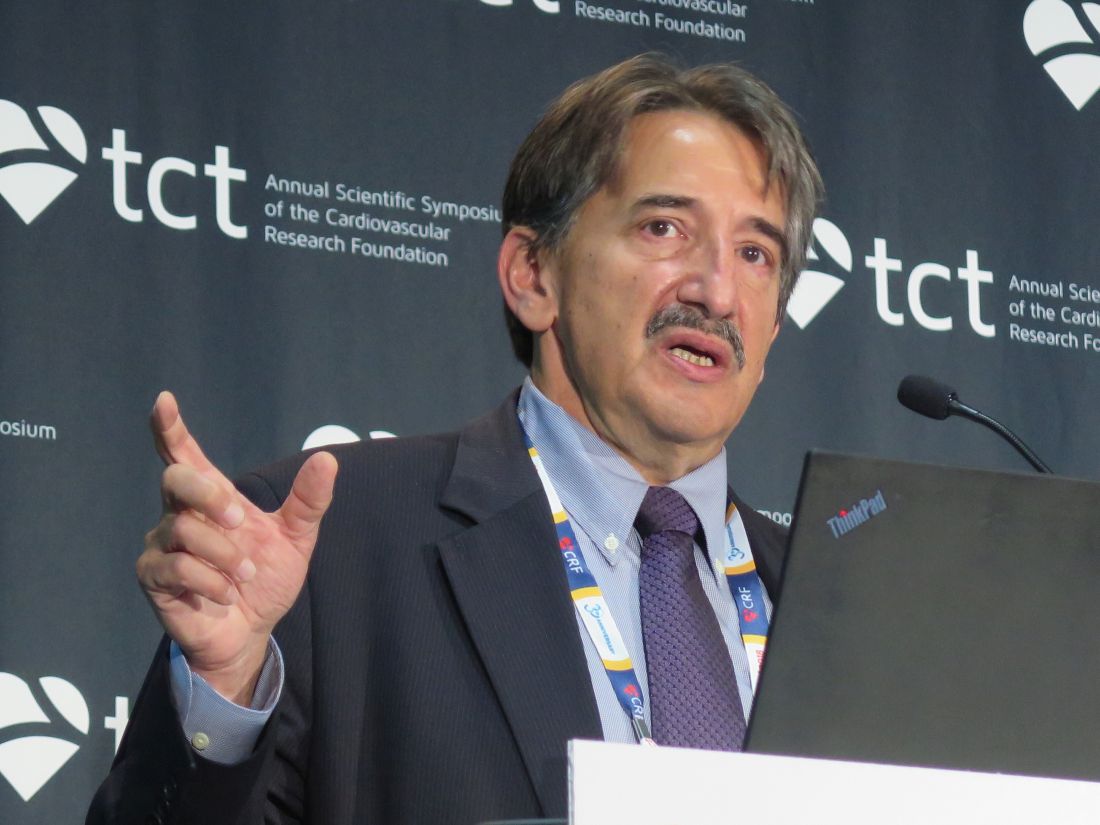User login
Drug-coated stent bests bare metal in patients with high bleeding risk
SAN DIEGO – Positive results of the LEADERS FREE II trial in patients with high bleeding risk undergoing percutaneous coronary intervention may pave the way for approval of a new drug-coated stent in the United States and possibly spell the end for bare-metal stents.
The stent studied – a polymer-free umirolimus-coated stent – is currently marketed in Europe as BioFreedom (Biosensors International). It outperformed a very similar bare-metal stent (Gazelle, manufactured by Biosensors Interventional Technologies) in the randomized LEADERS FREE trial, which was conducted outside the United States (N Engl J Med. 2015 Nov 19;373[21]:2038-47). The single-arm LEADERS FREE II (NCT02843633) trial was undertaken to confirm those findings, assess their generalizability in a North American population, and obtain data to support regulatory approval of the stent in the United States, explained presenting author Mitchell W. Krucoff, MD, a professor of medicine and member in the Duke Clinical Research Institute, Duke University, Durham, N.C. All patients received drug-coated stents because it was considered unethical to randomize any to bare-metal stents after the preceding trial. As in that trial, all patients received 1 month of dual-antiplatelet therapy.
Compared with the 1,211 propensity-matched patients treated with bare metal stents in the LEADERS FREE trial, the 1,203 patients treated with drug-coated stents in the LEADERS FREE II trial had a 33% lower risk of primary safety events (a composite of cardiac death and myocardial infarction) and a 37% lower risk of primary efficacy events (clinically driven target lesion revascularization) at 1 year, according to the study’s main results. Secondary outcomes were all similar or better with the drug-coated stents.
“This study demonstrates reproducibility of the randomized LEADERS FREE findings showing superior safety … and superior effectiveness … of the drug-coated stent over the bare-metal stent,” Dr. Krucoff said. “This study also, by enrolling more than half of patients in North America, supports the generalizability of the findings to patients on both sides of the Atlantic.”
Parsing the findings
When asked whether the Food and Drug Administration should approve this stent and whether he would use it for his patients, Dr. Krucoff gave a “yes, but …” reply. “The but here is, we have a lot to learn in this area. These are patients who by and large have been excluded from every pivotal drug-eluting stent study and every pivotal dual-antiplatelet study,” he elaborated. It is therefore unclear, for example, how the stent will perform as more are treated and what the optimal duration of dual-antiplatelet therapy is. Nonetheless, given that these patients make up a sizable share of the PCI [percutaneous coronary intervention] population and that some centers still commonly use bare-metal stents, “I think bringing this stent forward with a label for 30 days [of dual-antiplatelet therapy] in high bleeding risk patients is a yes.”
“To me, the main driving factor for an expeditious [approval] process is, if you put a conservatively critical eye to this, you could say that LEADERS FREE alerts us to a safety signal [about] our intuitive behavior practice of putting bare-metal stents in patients who we know are at high bleeding risk, so we are only going to treat them with 30 days of dual-antiplatelet therapy. There is actually a safety signal that we are potentially doing harm, based on at least one look at this,” Dr. Krucoff added. “There is no question, I think FDA decisions are primarily driven by safety concerns. The unusual thing here is, it’s not a safety concern as a defect in the device, it’s a safety concern relative to our current practice.”
Trial details
On average, the patients enrolled in LEADERS FREE II were generally similar to counterparts enrolled in LEADERS FREE and had an average of 1.74 factors putting them at high risk for bleeding, according to Dr. Krucoff. Of note, it was an all-comers trial in that there was no restriction on coronary anatomy, lesion complexity, or clinical presentation.
Results reported at the meeting, which was sponsored by the Cardiovascular Research Foundation, showed that the rate of the primary safety endpoint – the composite of cardiac death and myocardial infarction at 1 year – was 8.6% with the drug-coated stent and 12.3% with the bare-metal stent, for an absolute risk difference of –3.7% (hazard ratio, 0.67; P for noninferiority less than .0001; P for superiority = .0025).
Findings were significant for each component individually and were generally consistent across patient subgroups, Dr. Krucoff said. Secondary safety endpoints showed “no sign of a safety signal or concern with the drug-coated stent platform with 30 days of dual-antiplatelet therapy.”
In an additional analysis, the unadjusted rates of the primary safety endpoint were was 8.6% and 9.0% with the drug-coated stent in the LEADERS FREE II and the LEADERS FREE populations, respectively, compared with 12.4% with the bare-metal stent.
The rate of the primary efficacy endpoint – clinically driven target lesion revascularization at 1 year – was 6.1% with the drug-coated stent and 9.3% with the bare-metal stent, for an absolute risk difference of –3.2% (hazard ratio, 0.63; P for superiority = .0111). Findings again were consistently in favor of the drug-coated stent across most patient subgroups, with the exception of patients having renal failure at the time of admission. Secondary efficacy endpoints all significantly favored that stent as well.
The 1-year rates of bleeding overall and by severity were statistically indistinguishable, Dr. Krucoff reported. The rate of severe bleeding – Bleeding Academic Research Consortium (BARC) type 3-5 – was 7.0% with the drug-coated stent and 7.3% with the bare metal stent.
Dr. Krucoff disclosed that he has various affiliations and financial relationships with Abbott Vascular, Biosensors, Boston Scientific, CSI, Medtronic, OrbusNeich, and Terumo. The trial was sponsored by Biosensors.
SAN DIEGO – Positive results of the LEADERS FREE II trial in patients with high bleeding risk undergoing percutaneous coronary intervention may pave the way for approval of a new drug-coated stent in the United States and possibly spell the end for bare-metal stents.
The stent studied – a polymer-free umirolimus-coated stent – is currently marketed in Europe as BioFreedom (Biosensors International). It outperformed a very similar bare-metal stent (Gazelle, manufactured by Biosensors Interventional Technologies) in the randomized LEADERS FREE trial, which was conducted outside the United States (N Engl J Med. 2015 Nov 19;373[21]:2038-47). The single-arm LEADERS FREE II (NCT02843633) trial was undertaken to confirm those findings, assess their generalizability in a North American population, and obtain data to support regulatory approval of the stent in the United States, explained presenting author Mitchell W. Krucoff, MD, a professor of medicine and member in the Duke Clinical Research Institute, Duke University, Durham, N.C. All patients received drug-coated stents because it was considered unethical to randomize any to bare-metal stents after the preceding trial. As in that trial, all patients received 1 month of dual-antiplatelet therapy.
Compared with the 1,211 propensity-matched patients treated with bare metal stents in the LEADERS FREE trial, the 1,203 patients treated with drug-coated stents in the LEADERS FREE II trial had a 33% lower risk of primary safety events (a composite of cardiac death and myocardial infarction) and a 37% lower risk of primary efficacy events (clinically driven target lesion revascularization) at 1 year, according to the study’s main results. Secondary outcomes were all similar or better with the drug-coated stents.
“This study demonstrates reproducibility of the randomized LEADERS FREE findings showing superior safety … and superior effectiveness … of the drug-coated stent over the bare-metal stent,” Dr. Krucoff said. “This study also, by enrolling more than half of patients in North America, supports the generalizability of the findings to patients on both sides of the Atlantic.”
Parsing the findings
When asked whether the Food and Drug Administration should approve this stent and whether he would use it for his patients, Dr. Krucoff gave a “yes, but …” reply. “The but here is, we have a lot to learn in this area. These are patients who by and large have been excluded from every pivotal drug-eluting stent study and every pivotal dual-antiplatelet study,” he elaborated. It is therefore unclear, for example, how the stent will perform as more are treated and what the optimal duration of dual-antiplatelet therapy is. Nonetheless, given that these patients make up a sizable share of the PCI [percutaneous coronary intervention] population and that some centers still commonly use bare-metal stents, “I think bringing this stent forward with a label for 30 days [of dual-antiplatelet therapy] in high bleeding risk patients is a yes.”
“To me, the main driving factor for an expeditious [approval] process is, if you put a conservatively critical eye to this, you could say that LEADERS FREE alerts us to a safety signal [about] our intuitive behavior practice of putting bare-metal stents in patients who we know are at high bleeding risk, so we are only going to treat them with 30 days of dual-antiplatelet therapy. There is actually a safety signal that we are potentially doing harm, based on at least one look at this,” Dr. Krucoff added. “There is no question, I think FDA decisions are primarily driven by safety concerns. The unusual thing here is, it’s not a safety concern as a defect in the device, it’s a safety concern relative to our current practice.”
Trial details
On average, the patients enrolled in LEADERS FREE II were generally similar to counterparts enrolled in LEADERS FREE and had an average of 1.74 factors putting them at high risk for bleeding, according to Dr. Krucoff. Of note, it was an all-comers trial in that there was no restriction on coronary anatomy, lesion complexity, or clinical presentation.
Results reported at the meeting, which was sponsored by the Cardiovascular Research Foundation, showed that the rate of the primary safety endpoint – the composite of cardiac death and myocardial infarction at 1 year – was 8.6% with the drug-coated stent and 12.3% with the bare-metal stent, for an absolute risk difference of –3.7% (hazard ratio, 0.67; P for noninferiority less than .0001; P for superiority = .0025).
Findings were significant for each component individually and were generally consistent across patient subgroups, Dr. Krucoff said. Secondary safety endpoints showed “no sign of a safety signal or concern with the drug-coated stent platform with 30 days of dual-antiplatelet therapy.”
In an additional analysis, the unadjusted rates of the primary safety endpoint were was 8.6% and 9.0% with the drug-coated stent in the LEADERS FREE II and the LEADERS FREE populations, respectively, compared with 12.4% with the bare-metal stent.
The rate of the primary efficacy endpoint – clinically driven target lesion revascularization at 1 year – was 6.1% with the drug-coated stent and 9.3% with the bare-metal stent, for an absolute risk difference of –3.2% (hazard ratio, 0.63; P for superiority = .0111). Findings again were consistently in favor of the drug-coated stent across most patient subgroups, with the exception of patients having renal failure at the time of admission. Secondary efficacy endpoints all significantly favored that stent as well.
The 1-year rates of bleeding overall and by severity were statistically indistinguishable, Dr. Krucoff reported. The rate of severe bleeding – Bleeding Academic Research Consortium (BARC) type 3-5 – was 7.0% with the drug-coated stent and 7.3% with the bare metal stent.
Dr. Krucoff disclosed that he has various affiliations and financial relationships with Abbott Vascular, Biosensors, Boston Scientific, CSI, Medtronic, OrbusNeich, and Terumo. The trial was sponsored by Biosensors.
SAN DIEGO – Positive results of the LEADERS FREE II trial in patients with high bleeding risk undergoing percutaneous coronary intervention may pave the way for approval of a new drug-coated stent in the United States and possibly spell the end for bare-metal stents.
The stent studied – a polymer-free umirolimus-coated stent – is currently marketed in Europe as BioFreedom (Biosensors International). It outperformed a very similar bare-metal stent (Gazelle, manufactured by Biosensors Interventional Technologies) in the randomized LEADERS FREE trial, which was conducted outside the United States (N Engl J Med. 2015 Nov 19;373[21]:2038-47). The single-arm LEADERS FREE II (NCT02843633) trial was undertaken to confirm those findings, assess their generalizability in a North American population, and obtain data to support regulatory approval of the stent in the United States, explained presenting author Mitchell W. Krucoff, MD, a professor of medicine and member in the Duke Clinical Research Institute, Duke University, Durham, N.C. All patients received drug-coated stents because it was considered unethical to randomize any to bare-metal stents after the preceding trial. As in that trial, all patients received 1 month of dual-antiplatelet therapy.
Compared with the 1,211 propensity-matched patients treated with bare metal stents in the LEADERS FREE trial, the 1,203 patients treated with drug-coated stents in the LEADERS FREE II trial had a 33% lower risk of primary safety events (a composite of cardiac death and myocardial infarction) and a 37% lower risk of primary efficacy events (clinically driven target lesion revascularization) at 1 year, according to the study’s main results. Secondary outcomes were all similar or better with the drug-coated stents.
“This study demonstrates reproducibility of the randomized LEADERS FREE findings showing superior safety … and superior effectiveness … of the drug-coated stent over the bare-metal stent,” Dr. Krucoff said. “This study also, by enrolling more than half of patients in North America, supports the generalizability of the findings to patients on both sides of the Atlantic.”
Parsing the findings
When asked whether the Food and Drug Administration should approve this stent and whether he would use it for his patients, Dr. Krucoff gave a “yes, but …” reply. “The but here is, we have a lot to learn in this area. These are patients who by and large have been excluded from every pivotal drug-eluting stent study and every pivotal dual-antiplatelet study,” he elaborated. It is therefore unclear, for example, how the stent will perform as more are treated and what the optimal duration of dual-antiplatelet therapy is. Nonetheless, given that these patients make up a sizable share of the PCI [percutaneous coronary intervention] population and that some centers still commonly use bare-metal stents, “I think bringing this stent forward with a label for 30 days [of dual-antiplatelet therapy] in high bleeding risk patients is a yes.”
“To me, the main driving factor for an expeditious [approval] process is, if you put a conservatively critical eye to this, you could say that LEADERS FREE alerts us to a safety signal [about] our intuitive behavior practice of putting bare-metal stents in patients who we know are at high bleeding risk, so we are only going to treat them with 30 days of dual-antiplatelet therapy. There is actually a safety signal that we are potentially doing harm, based on at least one look at this,” Dr. Krucoff added. “There is no question, I think FDA decisions are primarily driven by safety concerns. The unusual thing here is, it’s not a safety concern as a defect in the device, it’s a safety concern relative to our current practice.”
Trial details
On average, the patients enrolled in LEADERS FREE II were generally similar to counterparts enrolled in LEADERS FREE and had an average of 1.74 factors putting them at high risk for bleeding, according to Dr. Krucoff. Of note, it was an all-comers trial in that there was no restriction on coronary anatomy, lesion complexity, or clinical presentation.
Results reported at the meeting, which was sponsored by the Cardiovascular Research Foundation, showed that the rate of the primary safety endpoint – the composite of cardiac death and myocardial infarction at 1 year – was 8.6% with the drug-coated stent and 12.3% with the bare-metal stent, for an absolute risk difference of –3.7% (hazard ratio, 0.67; P for noninferiority less than .0001; P for superiority = .0025).
Findings were significant for each component individually and were generally consistent across patient subgroups, Dr. Krucoff said. Secondary safety endpoints showed “no sign of a safety signal or concern with the drug-coated stent platform with 30 days of dual-antiplatelet therapy.”
In an additional analysis, the unadjusted rates of the primary safety endpoint were was 8.6% and 9.0% with the drug-coated stent in the LEADERS FREE II and the LEADERS FREE populations, respectively, compared with 12.4% with the bare-metal stent.
The rate of the primary efficacy endpoint – clinically driven target lesion revascularization at 1 year – was 6.1% with the drug-coated stent and 9.3% with the bare-metal stent, for an absolute risk difference of –3.2% (hazard ratio, 0.63; P for superiority = .0111). Findings again were consistently in favor of the drug-coated stent across most patient subgroups, with the exception of patients having renal failure at the time of admission. Secondary efficacy endpoints all significantly favored that stent as well.
The 1-year rates of bleeding overall and by severity were statistically indistinguishable, Dr. Krucoff reported. The rate of severe bleeding – Bleeding Academic Research Consortium (BARC) type 3-5 – was 7.0% with the drug-coated stent and 7.3% with the bare metal stent.
Dr. Krucoff disclosed that he has various affiliations and financial relationships with Abbott Vascular, Biosensors, Boston Scientific, CSI, Medtronic, OrbusNeich, and Terumo. The trial was sponsored by Biosensors.
REPORTING FROM TCT 2018
Key clinical point: The polymer-free umirolimus (Biolimus A9)–coated stent is superior to the bare-metal stent in patients at high bleeding risk when used with a month of dual-antiplatelet therapy.
Major finding: The drug-coated stent reduced 1-year risks of the composite of cardiac death and MI by 33% and clinically driven target lesion revascularization by 37% when compared with matched controls.
Study details: A single-arm trial of 1,203 patients at high bleeding risk undergoing PCI who were given drug-coated stents with 1 month of dual-antiplatelet therapy who were compared with 1,211 propensity-matched historical control patients given bare-metal stents (LEADERS FREE II trial).
Disclosures: Dr. Krucoff has various affiliations/financial relationships with Abbott Vascular, Biosensors, Boston Scientific, CSI, Medtronic, OrbusNeich, and Terumo. The trial was sponsored by Biosensors.
IMPERIAL: Eluvia stent tops Zilver PTX for PAD
SAN DIEGO – In the first randomized, head-to-head trial of drug-releasing stents for above-the-knee femoropopliteal peripheral artery disease (PAD), Boston Scientific’s polymer-coated, paclitaxel-eluting stent outperformed Cook Medical’s polymer-free, paclitaxel-coated stent.
At 12 months, primary patency was 86.8% (231/266) in the Eluvia group, versus 81.5% (106/130) among those randomized to Zilver PTX. About 5% of Eluvia patients (14/273) and 9% of patients in the Zilver PTX arm (12/133) had a major adverse event, defined as death within a month or target limb amputation or revascularization through 12 months. Both outcomes were statistically significant at P less than .0001. Overall, 4.5% of Eluvia patients (13/287) required target lesion revascularization, compared with 9% of Zilver PTX patients (13/145).
“These data suggest the Boston Scientific product is superior. Unless there are big differences in cost or technical aspects of the procedure, I would foresee a fairly substantial shift to” Eluvia if it’s approved, which seems likely, said interventional cardiologist David Cohen, MD, of Saint Luke’s Mid America Heart Institute, Kansas City, Mo., who comoderated the study presentation at the Transcatheter Cardiovascular Therapeutics annual meeting.
There were six cases of aneurysmal degeneration with Eluvia, but none with Zilver PTX. All six patients were patent at 1 year, without revascularization or stent thrombosis. It’s too early to know what to make of the finding. The planned 5-year follow-up should shed some light on the issue, Dr. Gray said.
At present, there’s no clear algorithm for above-the-knee PAD. Balloons and stents – both drug-releasing and bare – are all in play, and new devices are on the way. “With a head-to-head trial like this, we are staring to pare down all the noise in the market place. I think for long complicated lesions, I would be very surprised if we don’t start seeing more drug-eluting stents, because the results are so good. Drug-coated balloons are useful, but they take a little bit longer and a little more nuance,” especially when stent are used to touch up the results, he said.
“If [Boston Scientific] prices this at a premium and my doctors come to me and say ‘You’ve got to let us buy this,’ it’s going to be a hard sell for me,” said Dr. Jaff, a professor of medicine at Harvard Medical School, Boston, and president of the nearby Newton-Wellesley Hospital in Newton, Mass.
As for shifting away from drug-coated balloons, which are an increasingly popular option, a head-to-head trial is in order. If it turns out Eluvia doesn’t “have a huge advantage, I’d start off with a drug-coated balloon. You leave yourself every option going down the road if it fails. If you have a stent that fails, it’s harder to work with,” he said.
About two-thirds of the subjects were men, and the mean age was about 68 years. Most patients in both arms had marked improvements in symptoms and walking ability after stent placement. Rates of stent thrombosis were low, at about 2% with Eluvia versus 4% with Zilver PTX, a statistically nonsignificant difference.
The IMPERIAL results were published online simultaneously with Dr. Gray’s presentation (Lancet. 2018 Sep 22. doi: 10.1016/S0140-6736[18]32262-1).
The work was funded and conducted by Boston Scientific. Dr. Gray and Dr. Jaffe are advisors to the company. Most of the other investigators disclosed financial ties to company, and one was an employee. Dr. Cohen wasn’t involved in the work. The TCT meeting was sponsored by the Cardiovascular Research Foundation.
SAN DIEGO – In the first randomized, head-to-head trial of drug-releasing stents for above-the-knee femoropopliteal peripheral artery disease (PAD), Boston Scientific’s polymer-coated, paclitaxel-eluting stent outperformed Cook Medical’s polymer-free, paclitaxel-coated stent.
At 12 months, primary patency was 86.8% (231/266) in the Eluvia group, versus 81.5% (106/130) among those randomized to Zilver PTX. About 5% of Eluvia patients (14/273) and 9% of patients in the Zilver PTX arm (12/133) had a major adverse event, defined as death within a month or target limb amputation or revascularization through 12 months. Both outcomes were statistically significant at P less than .0001. Overall, 4.5% of Eluvia patients (13/287) required target lesion revascularization, compared with 9% of Zilver PTX patients (13/145).
“These data suggest the Boston Scientific product is superior. Unless there are big differences in cost or technical aspects of the procedure, I would foresee a fairly substantial shift to” Eluvia if it’s approved, which seems likely, said interventional cardiologist David Cohen, MD, of Saint Luke’s Mid America Heart Institute, Kansas City, Mo., who comoderated the study presentation at the Transcatheter Cardiovascular Therapeutics annual meeting.
There were six cases of aneurysmal degeneration with Eluvia, but none with Zilver PTX. All six patients were patent at 1 year, without revascularization or stent thrombosis. It’s too early to know what to make of the finding. The planned 5-year follow-up should shed some light on the issue, Dr. Gray said.
At present, there’s no clear algorithm for above-the-knee PAD. Balloons and stents – both drug-releasing and bare – are all in play, and new devices are on the way. “With a head-to-head trial like this, we are staring to pare down all the noise in the market place. I think for long complicated lesions, I would be very surprised if we don’t start seeing more drug-eluting stents, because the results are so good. Drug-coated balloons are useful, but they take a little bit longer and a little more nuance,” especially when stent are used to touch up the results, he said.
“If [Boston Scientific] prices this at a premium and my doctors come to me and say ‘You’ve got to let us buy this,’ it’s going to be a hard sell for me,” said Dr. Jaff, a professor of medicine at Harvard Medical School, Boston, and president of the nearby Newton-Wellesley Hospital in Newton, Mass.
As for shifting away from drug-coated balloons, which are an increasingly popular option, a head-to-head trial is in order. If it turns out Eluvia doesn’t “have a huge advantage, I’d start off with a drug-coated balloon. You leave yourself every option going down the road if it fails. If you have a stent that fails, it’s harder to work with,” he said.
About two-thirds of the subjects were men, and the mean age was about 68 years. Most patients in both arms had marked improvements in symptoms and walking ability after stent placement. Rates of stent thrombosis were low, at about 2% with Eluvia versus 4% with Zilver PTX, a statistically nonsignificant difference.
The IMPERIAL results were published online simultaneously with Dr. Gray’s presentation (Lancet. 2018 Sep 22. doi: 10.1016/S0140-6736[18]32262-1).
The work was funded and conducted by Boston Scientific. Dr. Gray and Dr. Jaffe are advisors to the company. Most of the other investigators disclosed financial ties to company, and one was an employee. Dr. Cohen wasn’t involved in the work. The TCT meeting was sponsored by the Cardiovascular Research Foundation.
SAN DIEGO – In the first randomized, head-to-head trial of drug-releasing stents for above-the-knee femoropopliteal peripheral artery disease (PAD), Boston Scientific’s polymer-coated, paclitaxel-eluting stent outperformed Cook Medical’s polymer-free, paclitaxel-coated stent.
At 12 months, primary patency was 86.8% (231/266) in the Eluvia group, versus 81.5% (106/130) among those randomized to Zilver PTX. About 5% of Eluvia patients (14/273) and 9% of patients in the Zilver PTX arm (12/133) had a major adverse event, defined as death within a month or target limb amputation or revascularization through 12 months. Both outcomes were statistically significant at P less than .0001. Overall, 4.5% of Eluvia patients (13/287) required target lesion revascularization, compared with 9% of Zilver PTX patients (13/145).
“These data suggest the Boston Scientific product is superior. Unless there are big differences in cost or technical aspects of the procedure, I would foresee a fairly substantial shift to” Eluvia if it’s approved, which seems likely, said interventional cardiologist David Cohen, MD, of Saint Luke’s Mid America Heart Institute, Kansas City, Mo., who comoderated the study presentation at the Transcatheter Cardiovascular Therapeutics annual meeting.
There were six cases of aneurysmal degeneration with Eluvia, but none with Zilver PTX. All six patients were patent at 1 year, without revascularization or stent thrombosis. It’s too early to know what to make of the finding. The planned 5-year follow-up should shed some light on the issue, Dr. Gray said.
At present, there’s no clear algorithm for above-the-knee PAD. Balloons and stents – both drug-releasing and bare – are all in play, and new devices are on the way. “With a head-to-head trial like this, we are staring to pare down all the noise in the market place. I think for long complicated lesions, I would be very surprised if we don’t start seeing more drug-eluting stents, because the results are so good. Drug-coated balloons are useful, but they take a little bit longer and a little more nuance,” especially when stent are used to touch up the results, he said.
“If [Boston Scientific] prices this at a premium and my doctors come to me and say ‘You’ve got to let us buy this,’ it’s going to be a hard sell for me,” said Dr. Jaff, a professor of medicine at Harvard Medical School, Boston, and president of the nearby Newton-Wellesley Hospital in Newton, Mass.
As for shifting away from drug-coated balloons, which are an increasingly popular option, a head-to-head trial is in order. If it turns out Eluvia doesn’t “have a huge advantage, I’d start off with a drug-coated balloon. You leave yourself every option going down the road if it fails. If you have a stent that fails, it’s harder to work with,” he said.
About two-thirds of the subjects were men, and the mean age was about 68 years. Most patients in both arms had marked improvements in symptoms and walking ability after stent placement. Rates of stent thrombosis were low, at about 2% with Eluvia versus 4% with Zilver PTX, a statistically nonsignificant difference.
The IMPERIAL results were published online simultaneously with Dr. Gray’s presentation (Lancet. 2018 Sep 22. doi: 10.1016/S0140-6736[18]32262-1).
The work was funded and conducted by Boston Scientific. Dr. Gray and Dr. Jaffe are advisors to the company. Most of the other investigators disclosed financial ties to company, and one was an employee. Dr. Cohen wasn’t involved in the work. The TCT meeting was sponsored by the Cardiovascular Research Foundation.
REPORTING FROM TCT 2018
Key clinical point: A drug-eluting stent under development for peripheral artery disease outperformed the only one currently on the market in the United States.
Major finding: At 12 months, primary patency was 86.8% in the Eluvia group versus 81.5% among those randomized to Zilver PTX.
Study details: IMPERIAL was a head-to-head randomized trial with 465 subjects comparing two stents for femoropopliteal PAD.
Disclosures: The work was funded and conducted by Boston Scientific. Most of the investigators disclosed financial ties to company; one was an employee.
Connecting at TCT 2018
The 30th anniversary of the Transcatheter Cardiovascular Therapeutics meeting in San Diego, sponsored by the Cardiovascular Research Foundation, will be the temporary home of more than 10,000 attendees. That’s up from about 9,400 last year.
Even so, that leaves a lot of folks who can’t be in sunny California. Keep in touch with friends near and far by using social media. Twitter hashtags for the meeting are #TCT2018 and #TCTConference.
The organizers encourage attendees to share their experiences and the educational content from the meeting, keeping in mind embargoes and some limitations, by posting photos, slides, or short video clips. Also, presentation slides will be online immediately after the sessions.
Attendees also can connect with each other using the the CRF Events app, available for free download here. But we recommend that meet outside if you can, considering the weather report.
The 30th anniversary of the Transcatheter Cardiovascular Therapeutics meeting in San Diego, sponsored by the Cardiovascular Research Foundation, will be the temporary home of more than 10,000 attendees. That’s up from about 9,400 last year.
Even so, that leaves a lot of folks who can’t be in sunny California. Keep in touch with friends near and far by using social media. Twitter hashtags for the meeting are #TCT2018 and #TCTConference.
The organizers encourage attendees to share their experiences and the educational content from the meeting, keeping in mind embargoes and some limitations, by posting photos, slides, or short video clips. Also, presentation slides will be online immediately after the sessions.
Attendees also can connect with each other using the the CRF Events app, available for free download here. But we recommend that meet outside if you can, considering the weather report.
The 30th anniversary of the Transcatheter Cardiovascular Therapeutics meeting in San Diego, sponsored by the Cardiovascular Research Foundation, will be the temporary home of more than 10,000 attendees. That’s up from about 9,400 last year.
Even so, that leaves a lot of folks who can’t be in sunny California. Keep in touch with friends near and far by using social media. Twitter hashtags for the meeting are #TCT2018 and #TCTConference.
The organizers encourage attendees to share their experiences and the educational content from the meeting, keeping in mind embargoes and some limitations, by posting photos, slides, or short video clips. Also, presentation slides will be online immediately after the sessions.
Attendees also can connect with each other using the the CRF Events app, available for free download here. But we recommend that meet outside if you can, considering the weather report.
TCT presents new, ‘massive’ integrated, hands-on learning center
pavilions devoted to specific fields.
This major innovation brings TCT back to basics, Juan F. Granada, MD, president and CEO of the Cardiovascular Research Foundation and codirector of Transcatheter Cardiovascular Therapeutics, said in an interview.
Dr. Granada was closely involved with the program and said it’s been in the works for a couple of years. The emphasis of these workshops is to teach physicians an understanding of anatomy. TCT is devoting a massive amount of space to this effort, about 60% of the exhibit hall. The eight pavilions are dedicated to training tracks, and every single tool available to interventional cardiologists will be there, he said.
If you preregistered before all 4,000 spots filled up some days ago, consider yourself lucky. But be assured that the TCT organizers are tracking the registrations, even those submitted after the limit was reached, to help them plan for next year’s meeting in San Francisco.
The workshops will run over 3 days, from Saturday through Monday, Sept. 22-24.
pavilions devoted to specific fields.
This major innovation brings TCT back to basics, Juan F. Granada, MD, president and CEO of the Cardiovascular Research Foundation and codirector of Transcatheter Cardiovascular Therapeutics, said in an interview.
Dr. Granada was closely involved with the program and said it’s been in the works for a couple of years. The emphasis of these workshops is to teach physicians an understanding of anatomy. TCT is devoting a massive amount of space to this effort, about 60% of the exhibit hall. The eight pavilions are dedicated to training tracks, and every single tool available to interventional cardiologists will be there, he said.
If you preregistered before all 4,000 spots filled up some days ago, consider yourself lucky. But be assured that the TCT organizers are tracking the registrations, even those submitted after the limit was reached, to help them plan for next year’s meeting in San Francisco.
The workshops will run over 3 days, from Saturday through Monday, Sept. 22-24.
pavilions devoted to specific fields.
This major innovation brings TCT back to basics, Juan F. Granada, MD, president and CEO of the Cardiovascular Research Foundation and codirector of Transcatheter Cardiovascular Therapeutics, said in an interview.
Dr. Granada was closely involved with the program and said it’s been in the works for a couple of years. The emphasis of these workshops is to teach physicians an understanding of anatomy. TCT is devoting a massive amount of space to this effort, about 60% of the exhibit hall. The eight pavilions are dedicated to training tracks, and every single tool available to interventional cardiologists will be there, he said.
If you preregistered before all 4,000 spots filled up some days ago, consider yourself lucky. But be assured that the TCT organizers are tracking the registrations, even those submitted after the limit was reached, to help them plan for next year’s meeting in San Francisco.
The workshops will run over 3 days, from Saturday through Monday, Sept. 22-24.
Top research at TCT 2018
The research area that rose to the top in terms of importance to practice at the upcoming Transcatheter Cardiovascular Therapeutics meeting in San Diego is in mitral valve interventions, but there’s much more potentially practice-changing original reporting as well.
Of the 155 abstracts considered for Late-Breaking Trials, only 10% were selected. That’s in addition to the other 1,650 abstracts submitted for the meeting.
The research chosen for the Late-Breaking Trial and Late-Breaking Research sessions held on Saturday, Sept. 22, through Tuesday, Sept. 25, fall into four categories, Juan F. Granada, MD, president and CEO of the Cardiovascular Research Foundation and codirector of Transcatheter Cardiovascular Therapeutics, said in an interview.
The first and most important category is mitral intervention, he said, and the studies with the most potential to change U.S. practice will be presented on Sunday morning at 10:15-11:15 in the Late-Breaking Trial session. The session kicks off with COAPT, the long-anticipated trial that randomized patients with severe mitral regurgitation secondary to heart failure to the MitraClip or to optimal medical management. The MitraClip, which doesn’t entail a concomitant annuloplasty, currently is approved by the Food and Drug Administration for patients with primary, degenerative mitral regurgitation not amenable to surgical repair only. But, if COAPT yields positive results, the role of the MitraClip may expand greatly.
Also presented in that Sunday session will be results of REDUCE-FMR, a sham-controlled trial in patients with heart failure–associated functional mitral regurgitation who received either treatment with the CARILLON Mitral Contour System, which is an indirect annuloplasty device, or optimal medical treatment.
Secondly, “we’ve got a lot to learn from two trials in the Absorb bioresorbable scaffold,” Dr. Granada said. Although the device failed commercially on the heels of news of target vessel failure and scaffold thrombosis, detailed results of ABSORB IV and COMPARE ABSORB will inform future designs, he said.The third area Dr. Granada emphasized was direct comparisons of stents. Saturday’s Late-Breaking Trials sessions offer results of several head-to-head trials. BIONYX compared the bioresorbable polymer Orsiro stent with the newer durable polymer Resolute Onyx. TALENT, unusual in its all-comers design, compared clinical outcomes at 12 months between the Supraflex ultrathin coronary stent and Xience everolimus eluting system. Whether strut thickness can make a difference in outcomes will be of great interest as the results of these and other trials are presented at the meeting.
Lastly, an endovascular trial comparing two stents in long lesion, IMPERIAL, will be of interest. It randomized patients with chronic, symptomatic superficial femoral or proximal popliteal artery lesions to treatment with either the Eluvia vascular stent or the Zilver PTX, the first drug-eluting stent approved for use in these patients.
Remember, there also are oral abstract and moderated poster sessions happening throughout the meeting, so there’s something for everyone.
The research area that rose to the top in terms of importance to practice at the upcoming Transcatheter Cardiovascular Therapeutics meeting in San Diego is in mitral valve interventions, but there’s much more potentially practice-changing original reporting as well.
Of the 155 abstracts considered for Late-Breaking Trials, only 10% were selected. That’s in addition to the other 1,650 abstracts submitted for the meeting.
The research chosen for the Late-Breaking Trial and Late-Breaking Research sessions held on Saturday, Sept. 22, through Tuesday, Sept. 25, fall into four categories, Juan F. Granada, MD, president and CEO of the Cardiovascular Research Foundation and codirector of Transcatheter Cardiovascular Therapeutics, said in an interview.
The first and most important category is mitral intervention, he said, and the studies with the most potential to change U.S. practice will be presented on Sunday morning at 10:15-11:15 in the Late-Breaking Trial session. The session kicks off with COAPT, the long-anticipated trial that randomized patients with severe mitral regurgitation secondary to heart failure to the MitraClip or to optimal medical management. The MitraClip, which doesn’t entail a concomitant annuloplasty, currently is approved by the Food and Drug Administration for patients with primary, degenerative mitral regurgitation not amenable to surgical repair only. But, if COAPT yields positive results, the role of the MitraClip may expand greatly.
Also presented in that Sunday session will be results of REDUCE-FMR, a sham-controlled trial in patients with heart failure–associated functional mitral regurgitation who received either treatment with the CARILLON Mitral Contour System, which is an indirect annuloplasty device, or optimal medical treatment.
Secondly, “we’ve got a lot to learn from two trials in the Absorb bioresorbable scaffold,” Dr. Granada said. Although the device failed commercially on the heels of news of target vessel failure and scaffold thrombosis, detailed results of ABSORB IV and COMPARE ABSORB will inform future designs, he said.The third area Dr. Granada emphasized was direct comparisons of stents. Saturday’s Late-Breaking Trials sessions offer results of several head-to-head trials. BIONYX compared the bioresorbable polymer Orsiro stent with the newer durable polymer Resolute Onyx. TALENT, unusual in its all-comers design, compared clinical outcomes at 12 months between the Supraflex ultrathin coronary stent and Xience everolimus eluting system. Whether strut thickness can make a difference in outcomes will be of great interest as the results of these and other trials are presented at the meeting.
Lastly, an endovascular trial comparing two stents in long lesion, IMPERIAL, will be of interest. It randomized patients with chronic, symptomatic superficial femoral or proximal popliteal artery lesions to treatment with either the Eluvia vascular stent or the Zilver PTX, the first drug-eluting stent approved for use in these patients.
Remember, there also are oral abstract and moderated poster sessions happening throughout the meeting, so there’s something for everyone.
The research area that rose to the top in terms of importance to practice at the upcoming Transcatheter Cardiovascular Therapeutics meeting in San Diego is in mitral valve interventions, but there’s much more potentially practice-changing original reporting as well.
Of the 155 abstracts considered for Late-Breaking Trials, only 10% were selected. That’s in addition to the other 1,650 abstracts submitted for the meeting.
The research chosen for the Late-Breaking Trial and Late-Breaking Research sessions held on Saturday, Sept. 22, through Tuesday, Sept. 25, fall into four categories, Juan F. Granada, MD, president and CEO of the Cardiovascular Research Foundation and codirector of Transcatheter Cardiovascular Therapeutics, said in an interview.
The first and most important category is mitral intervention, he said, and the studies with the most potential to change U.S. practice will be presented on Sunday morning at 10:15-11:15 in the Late-Breaking Trial session. The session kicks off with COAPT, the long-anticipated trial that randomized patients with severe mitral regurgitation secondary to heart failure to the MitraClip or to optimal medical management. The MitraClip, which doesn’t entail a concomitant annuloplasty, currently is approved by the Food and Drug Administration for patients with primary, degenerative mitral regurgitation not amenable to surgical repair only. But, if COAPT yields positive results, the role of the MitraClip may expand greatly.
Also presented in that Sunday session will be results of REDUCE-FMR, a sham-controlled trial in patients with heart failure–associated functional mitral regurgitation who received either treatment with the CARILLON Mitral Contour System, which is an indirect annuloplasty device, or optimal medical treatment.
Secondly, “we’ve got a lot to learn from two trials in the Absorb bioresorbable scaffold,” Dr. Granada said. Although the device failed commercially on the heels of news of target vessel failure and scaffold thrombosis, detailed results of ABSORB IV and COMPARE ABSORB will inform future designs, he said.The third area Dr. Granada emphasized was direct comparisons of stents. Saturday’s Late-Breaking Trials sessions offer results of several head-to-head trials. BIONYX compared the bioresorbable polymer Orsiro stent with the newer durable polymer Resolute Onyx. TALENT, unusual in its all-comers design, compared clinical outcomes at 12 months between the Supraflex ultrathin coronary stent and Xience everolimus eluting system. Whether strut thickness can make a difference in outcomes will be of great interest as the results of these and other trials are presented at the meeting.
Lastly, an endovascular trial comparing two stents in long lesion, IMPERIAL, will be of interest. It randomized patients with chronic, symptomatic superficial femoral or proximal popliteal artery lesions to treatment with either the Eluvia vascular stent or the Zilver PTX, the first drug-eluting stent approved for use in these patients.
Remember, there also are oral abstract and moderated poster sessions happening throughout the meeting, so there’s something for everyone.













